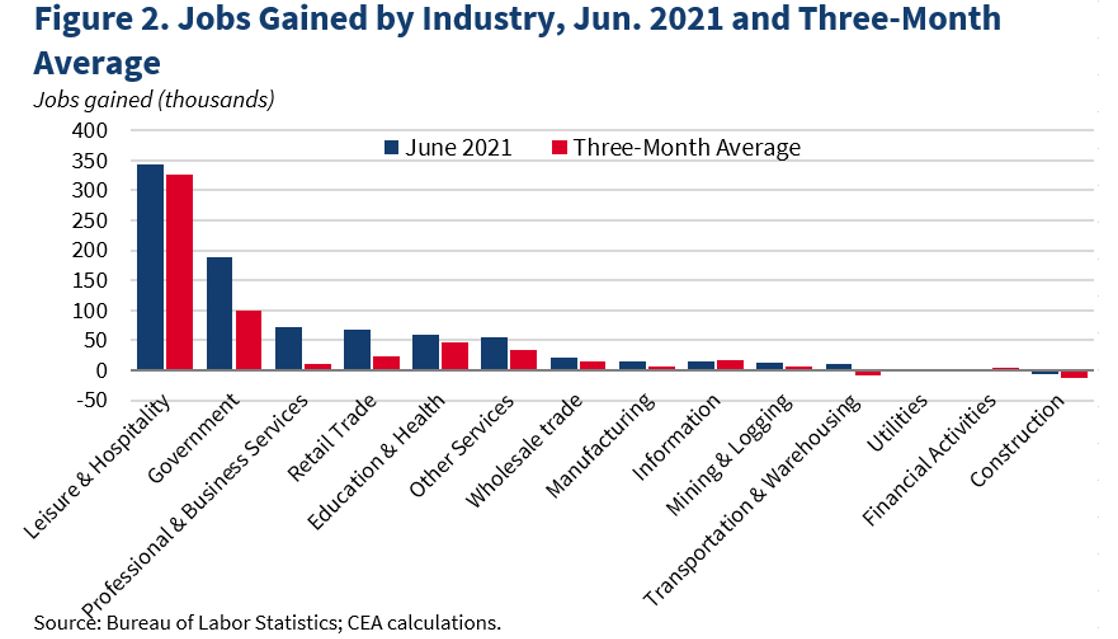 |
The U.S. economy grew at a blistering pace in the spring and repaired most of the damage caused by the pandemic thanks to widespread coronavirus vaccinations and a nearly full reopening of the economy.
The Q2 GDP report verifies that the American economy is capable of easily accommodating the Biden administration’s proposed infrastructure and American Family plan spending of some $4 trillion in additional government investments, should they be passed in their present form.
“Real gross domestic product (GDP) increased at an annual rate of 6.5 percent in the second quarter of 2021, reflecting the continued economic recovery, reopening of establishments, and continued government response related to the COVID-19 pandemic,” according to the Bureau of Economic Analysis (BEA).
This is huge after the first quarter’s 6.3 percent growth and shows both consumers and businesses are spending enough to boost GDP growth past the pre-pandemic level.
The increase in real GDP in the second quarter reflected increases in personal consumption expenditures (PCE), nonresidential fixed investment, exports, and state and local government spending that were partly offset by decreases in private inventory investment, residential fixed investment, and federal government spending. Imports, which are a subtraction in the calculation of GDP, increased.
Such growth should continue in the third quarter with agreement being reached on the $1 trillion national infrastructure plan after weeks of fits and starts, once the White House and a bipartisan group of senators agreed on major provisions of the package that’s key to President Joe Biden’s agenda.
The package includes $110 billion for highways, $65 billion for broadband and $73 billion to modernize the nation’s electric grid, according to a White House fact sheet. Additionally, there’s $25 billion for airports, $55 billion for waterworks and more than $50 billion to bolster infrastructure against cyber attacks and climate change. There’s also $7.5 billion for electric vehicle charging stations.
Government assistance payments in the form of loans to businesses and grants to state and local governments increased in Q2, while social benefits to households, such as the direct economic impact payments, declined. In the first quarter of 2021, real GDP increased 6.3 percent (revised), as I said.
“The $1.2 trillion Bipartisan Infrastructure Framework is a critical step in implementing President Biden’s Build Back Better vision,” said the White House fact sheet. “The Plan makes transformational and historic investments in clean transportation infrastructure, clean water infrastructure, universal broadband infrastructure, clean power infrastructure, remediation of legacy pollution, and resilience to the changing climate. Cumulatively across these areas, the Framework invests two-thirds of the resources that the President proposed in his American Jobs Plan.”
Inflation is running hot, as was expected from the sudden surge in demand that has GDP growth exceeding its pre-pandemic level. The PCE price index that the Fed prefers to measure inflation increased 6.4 percent, compared with an increase of 3.8 percent (revised). Excluding food and energy prices, the PCE price index increased 6.1 percent, compared with an increase of 2.7 percent (revised).
This level of inflation is worrisome if prolonged, but the Federal Reserve believes supply bottlenecks are causing the price rises that should subside once industry activity returns to normal and the 7 million workers still unemployed due to the pandemic return to work.
This is the biggest investment in America’s future since the Eisenhower and Kennedy days more than two generations ago when our tax monies were spent on real things; like our interstate highway system, moon landings, and development of the Internet.
These new government spending initiatives will find new ways to benefit workers in this new economy as other developed countries are doing—i.e., with governments working to pay it forward for future generations.
Harlan Green © 2021
Follow Harlan Green on Twitter: https://twitter.com/HarlanGreen













